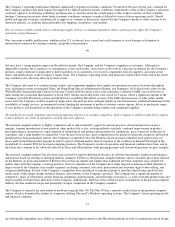Apple 2003 Annual Report Download - page 35
Download and view the complete annual report
Please find page 35 of the 2003 Apple annual report below. You can navigate through the pages in the report by either clicking on the pages listed below, or by using the keyword search tool below to find specific information within the annual report.
and functional advantages over competing platforms, including Windows.
The Company is currently focused on market opportunities related to digital music distribution and related consumer electronic devices
including iPods. The Company faces increasing competition from other companies promoting their own digital music distribution services, free
peer-to-peer music services, emerging companies, and larger companies that may have greater resources, including technical and marketing
resources, and supplier relationships. There can be no assurance that the Company will be able to provide products and services that effectively
compete in these markets. Failure to effectively compete could negatively affect the Company's operating results and financial position.
The Company has higher research and development and selling, general and administrative costs, as a percentage of revenue, than many of its
competitors.
The Company's ability to compete successfully and maintain attractive gross margins is heavily dependent upon its ability to ensure a
continuing and timely flow of innovative and competitive products and technologies to the marketplace. As a result, the Company incurs higher
research and development costs as a percentage of revenue than its competitors who sell personal computers based on other operating systems.
Many of these competitors seek to compete aggressively on price and maintain very low cost structures. Further, as a result of the expansion of
the Company's Retail segment and costs associated with marketing the Company's brand including its unique operating system, the Company
incurs higher selling costs as a percentage of revenue than many of its competitors. If the Company is unable to continue to develop and sell
innovative new products with attractive gross margins, its results of operations may be materially adversely affected by its operating cost
structure.
The Company must successfully manage frequent product introductions and transitions in order to remain competitive and effectively stimulate
customer demand.
Due to the highly volatile nature of the personal computer industry, which is characterized by dynamic customer demand patterns and rapid
technological advances, the Company must continually introduce new products and technologies, enhance existing products in order to remain
competitive, and effectively stimulate customer demand for new products and upgraded versions of the Company's existing products. The
success of new product introductions is dependent on a number of factors, including market acceptance; the Company's ability to manage the
risks associated with product transitions, including production ramp issues; the availability of application software for new products; the
effective management of inventory levels in line with anticipated product demand; the availability of products in appropriate quantities to meet
anticipated demand; and the risk that new products may have quality or other defects in the early stages of introduction. Accordingly, the
Company cannot determine in advance the ultimate effect that new products will have on its sales or results of operations.
During 2001, the Company introduced a new client operating system, Mac OS X, and delivered its first major upgrade, Mac OS X version
10.1. Other major upgrades include Mac OS X Jaguar in 2002 and most recently Mac OS X Panther in October 2003. Inability of the Company
to provide additional improvements in the performance and functionality of Mac OS X, advance customer acceptance of the new operating
system and its upgrades, obtain the continued commitment of software developers to transition existing applications to run on Mac OS X, or
create new applications to run on Mac OS X, may have an adverse impact on the Company's operating results and financial condition.
Because orders for components, and in some cases commitments to purchase components, must be placed in advance of customer orders, the
Company faces substantial inventory risk.
The Company records a write-down for inventories of components and products that have become obsolete or are in excess of anticipated
demand or net realizable value and accrues necessary reserves for cancellation fees of orders for inventories that have been cancelled. Although
the Company believes its
42
inventory and related provisions are adequate, given the rapid and unpredictable pace of product obsolescence in the computer industry, no
assurance can be given that the Company will not incur additional inventory and related charges. In addition, such charges have had, and may
have, a material effect on the Company's financial position and results of operations.
The Company must order components for its products and build inventory in advance of product shipments. Because the Company's markets
are volatile and subject to rapid technology and price changes, there is a risk the Company will forecast incorrectly and produce or order from
third parties excess or insufficient inventories of particular products. Consistent with industry practice, components are normally acquired
through a combination of formal purchase orders, supplier contracts, and open orders based on projected demand information. Such purchase
commitments typically cover the Company's forecasted component and manufacturing requirements for periods ranging from 30 to 130 days.
The Company's operating results and financial condition have been in the past and may in the future be materially adversely affected by the
Company's ability to manage its inventory levels and respond to short-term shifts in customer demand patterns.
Future operating results are dependent upon the Company's ability to obtain a sufficient supply of components, some of which are in short
supply or available only from limited sources.
























